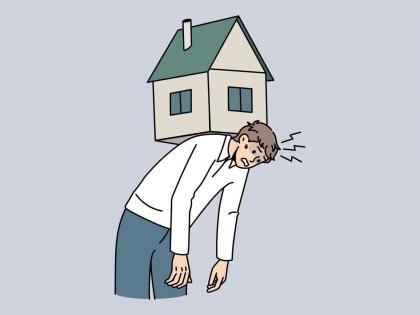The EMI–Burnout Loop: India's Silent Crisis
By Hemant Jain | Updated: September 18, 2025 10:47 IST2025-09-18T10:46:04+5:302025-09-18T10:47:25+5:30
India, as a welfare state, strives to meet the basic needs of its citizens—food, clothing, and shelter. However, the ...

The EMI–Burnout Loop: India's Silent Crisis
India, as a welfare state, strives to meet the basic needs of its citizens—food, clothing, and shelter. However, the growing financial pressures on the middle class are giving rise to a different kind of crisis: the "EMI–Burnout Loop." This silent epidemic is gradually trapping families in a cycle of debt that prevents them from progressing, both financially and mentally. The relentless pressure of Equated Monthly Installments (EMIs) not only strains personal finances but also creates a ripple effect on mental well-being, leaving families feeling anxious and overwhelmed day in day out.
The Growing Debt Burden
In recent years, household debt in India has been steadily rising, and by the end of 2024, it is expected to account for nearly 42% of the country’s GDP. This is primarily driven by housing loans and personal credit, with the middle class bearing the brunt. According to Knight Frank’s Affordability Index, the proportion of EMIs to income for middle-income households has increased dramatically from 28% in 2020 to nearly 40% by 2025. In cities like Mumbai, this figure is even more alarming, with families spending as much as half of their monthly income on loan repayments.
This “EMI squeeze” leaves little room for essential expenses like food, healthcare, and children's education, while simultaneously offering no space for emergency savings or long-term investments. In this scenario, a sudden job loss or a slight increase in interest rates can push many families into financial disarray.
The Pressure of Long Work Hours
To make ends meet and keep up with the burden of EMIs, employees are working longer hours and shouldering heavier workloads. India is among the most overworked countries globally, with nearly 50% of workers putting in more than 49 hours a week, according to the International Labour Organization. This intense pressure is especially felt in white-collar jobs, where late-night emails, weekend meetings, and cross-time-zone demands add to the exhaustion.
The result is a near-impossible work-life balance, with employees sacrificing their personal lives and health just to maintain financial stability. This pressure can quickly evolve into a public health crisis, as mental and physical well-being take a backseat to job security and debt management.
The Mental Health Toll
The cost of this financial and work-related pressure is mounting. According to the National Mental Health Survey, one in ten adults in India experiences some form of mental health disorder, with urban areas reporting even higher numbers. The most common conditions linked to the EMI–Burnout Loop include burnout, anxiety, and depression—conditions aggravated by the continuous strain of managing debt while balancing long work hours.
The signs of distress are already evident in society. The National Crime Records Bureau reports a rise in suicides linked to debt and bankruptcy, from 6,361 cases in 2021 to over 7,000 in 2022. Mental health helplines, such as Tele-MANAS, have also seen a surge in calls related to financial stress. In Telangana alone, over 1.3 lakh calls were received since 2022, with many callers citing overwhelming debt and the pressure of demanding work schedules.
This trend is a wake-up call for both employers and employees to rethink workplace practices and the larger economic structures that contribute to this cycle.
A Call for Change in Workplace Practices
Employers must recognize the importance of addressing mental health, especially in a society where employees are pushed to their limits by the EMI–Burnout Loop. Mental health should no longer be treated as a side issue addressed through occasional workshops. Instead, employers must implement structural changes, such as creating "quiet hours," ensuring employees have predictable time off, and offering support programs that combine financial planning and mental health counseling.
Financial Advice for Individuals
For individuals, the reality is tough but necessary: financial experts advise keeping EMIs below 30% of income and saving at least six months’ worth of living expenses. However, many families have already surpassed these thresholds, and the cycle seems inescapable. The only viable path forward is to find a balance between wants and financial reality. This could mean opting for a smaller home, postponing luxury purchases like a larger car, or prioritizing savings before upgrading one’s lifestyle.
The Link Between Financial Security and Mental Well-being
India's growth has largely been driven by the aspirations of its middle class. However, when these ambitions start to adversely affect mental health, they become a cause for concern. The EMI–Burnout Loop is not just an economic issue; it’s a deeply personal one, affecting real lives, futures, and the overall well-being of society. A country where families are one paycheck away from crisis and employees are burning out just to meet their debt obligations is not a strong society. The link between financial security and mental health must be recognized, as both are critical to the sustainability and health of the nation's future.
Open in app